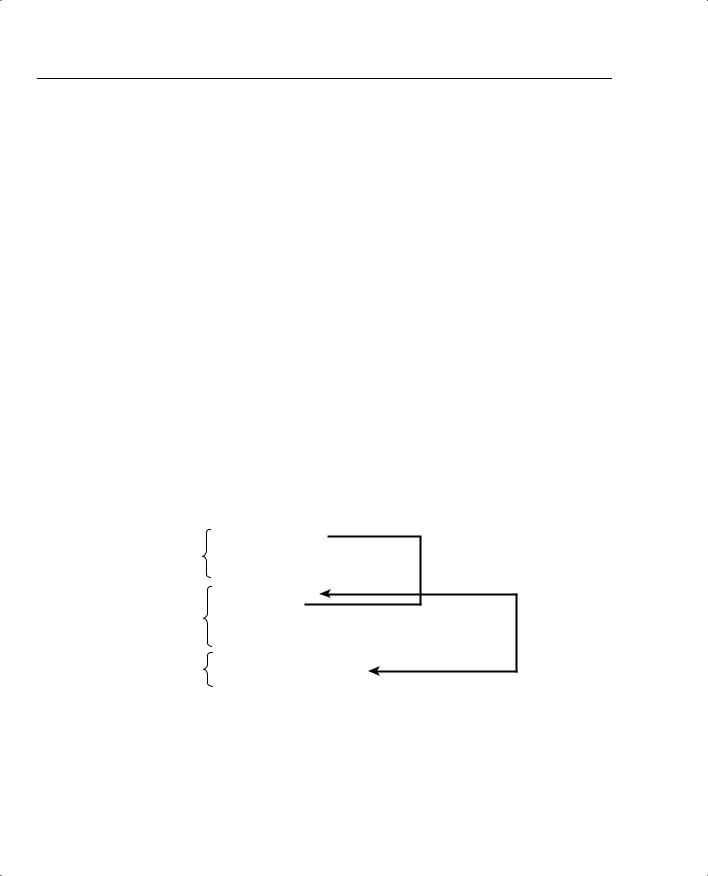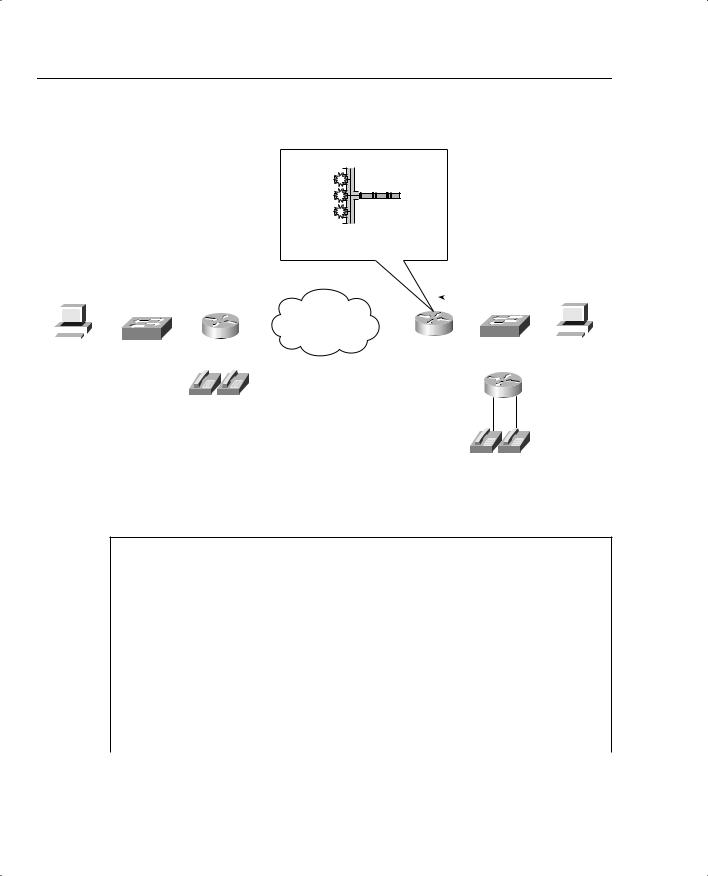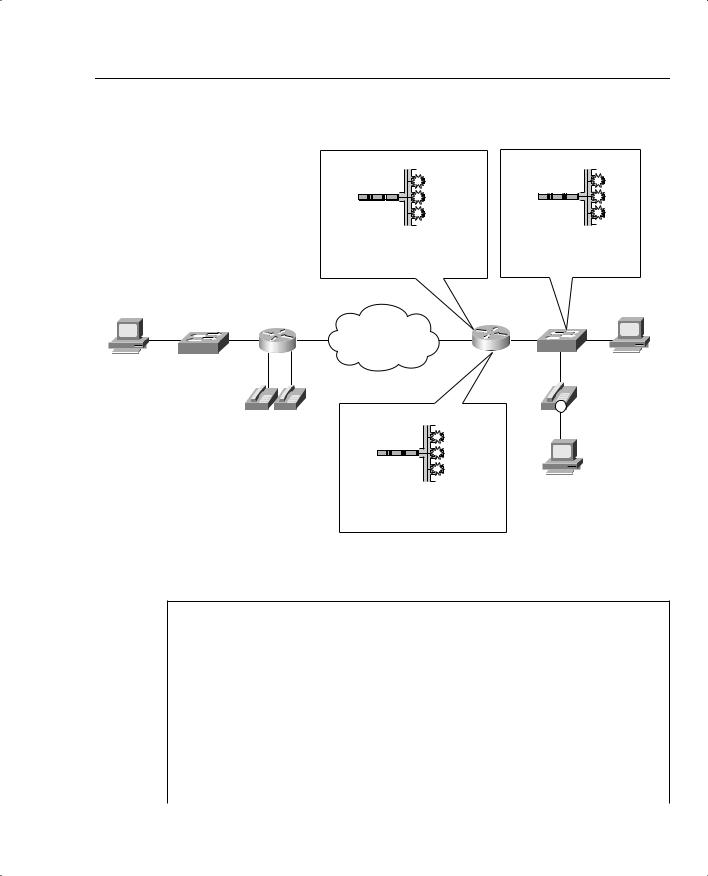
- •QoS Overview
- •“Do I Know This Already?” Quiz
- •QoS: Tuning Bandwidth, Delay, Jitter, and Loss Questions
- •Foundation Topics
- •QoS: Tuning Bandwidth, Delay, Jitter, and Loss
- •Bandwidth
- •The clock rate Command Versus the bandwidth Command
- •QoS Tools That Affect Bandwidth
- •Delay
- •Serialization Delay
- •Propagation Delay
- •Queuing Delay
- •Forwarding Delay
- •Shaping Delay
- •Network Delay
- •Delay Summary
- •QoS Tools That Affect Delay
- •Jitter
- •QoS Tools That Affect Jitter
- •Loss
- •QoS Tools That Affect Loss
- •Summary: QoS Characteristics: Bandwidth, Delay, Jitter, and Loss
- •Voice Basics
- •Voice Bandwidth Considerations
- •Voice Delay Considerations
- •Voice Jitter Considerations
- •Voice Loss Considerations
- •Video Basics
- •Video Bandwidth Considerations
- •Video Delay Considerations
- •Video Jitter Considerations
- •Video Loss Considerations
- •Comparing Voice and Video: Summary
- •IP Data Basics
- •Data Bandwidth Considerations
- •Data Delay Considerations
- •Data Jitter Considerations
- •Data Loss Considerations
- •Comparing Voice, Video, and Data: Summary
- •Foundation Summary
- •QoS Tools and Architectures
- •“Do I Know This Already?” Quiz
- •QoS Tools Questions
- •Differentiated Services Questions
- •Integrated Services Questions
- •Foundation Topics
- •Introduction to IOS QoS Tools
- •Queuing
- •Queuing Tools
- •Shaping and Policing
- •Shaping and Policing Tools
- •Congestion Avoidance
- •Congestion-Avoidance Tools
- •Call Admission Control and RSVP
- •CAC Tools
- •Management Tools
- •Summary
- •The Good-Old Common Sense QoS Model
- •GOCS Flow-Based QoS
- •GOCS Class-Based QoS
- •The Differentiated Services QoS Model
- •DiffServ Per-Hop Behaviors
- •The Class Selector PHB and DSCP Values
- •The Assured Forwarding PHB and DSCP Values
- •The Expedited Forwarding PHB and DSCP Values
- •The Integrated Services QoS Model
- •Foundation Summary
- •“Do I Know This Already?” Quiz Questions
- •CAR, PBR, and CB Marking Questions
- •Foundation Topics
- •Marking
- •IP Header QoS Fields: Precedence and DSCP
- •LAN Class of Service (CoS)
- •Other Marking Fields
- •Summary of Marking Fields
- •Class-Based Marking (CB Marking)
- •Network-Based Application Recognition (NBAR)
- •CB Marking show Commands
- •CB Marking Summary
- •Committed Access Rate (CAR)
- •CAR Marking Summary
- •Policy-Based Routing (PBR)
- •PBR Marking Summary
- •VoIP Dial Peer
- •VoIP Dial-Peer Summary
- •Foundation Summary
- •Congestion Management
- •“Do I Know This Already?” Quiz
- •Queuing Concepts Questions
- •WFQ and IP RTP Priority Questions
- •CBWFQ and LLQ Questions
- •Comparing Queuing Options Questions
- •Foundation Topics
- •Queuing Concepts
- •Output Queues, TX Rings, and TX Queues
- •Queuing on Interfaces Versus Subinterfaces and Virtual Circuits (VCs)
- •Summary of Queuing Concepts
- •Queuing Tools
- •FIFO Queuing
- •Priority Queuing
- •Custom Queuing
- •Weighted Fair Queuing (WFQ)
- •WFQ Scheduler: The Net Effect
- •WFQ Scheduling: The Process
- •WFQ Drop Policy, Number of Queues, and Queue Lengths
- •WFQ Summary
- •Class-Based WFQ (CBWFQ)
- •CBWFQ Summary
- •Low Latency Queuing (LLQ)
- •LLQ with More Than One Priority Queue
- •IP RTP Priority
- •Summary of Queuing Tool Features
- •Foundation Summary
- •Conceptual Questions
- •Priority Queuing and Custom Queuing
- •CBWFQ, LLQ, IP RTP Priority
- •Comparing Queuing Tool Options
- •“Do I Know This Already?” Quiz
- •Shaping and Policing Concepts Questions
- •Policing with CAR and CB Policer Questions
- •Shaping with FRTS, GTS, DTS, and CB Shaping
- •Foundation Topics
- •When and Where to Use Shaping and Policing
- •How Shaping Works
- •Where to Shape: Interfaces, Subinterfaces, and VCs
- •How Policing Works
- •CAR Internals
- •CB Policing Internals
- •Policing, but Not Discarding
- •Foundation Summary
- •Shaping and Policing Concepts
- •“Do I Know This Already?” Quiz
- •Congestion-Avoidance Concepts and RED Questions
- •WRED Questions
- •FRED Questions
- •Foundation Topics
- •TCP and UDP Reactions to Packet Loss
- •Tail Drop, Global Synchronization, and TCP Starvation
- •Random Early Detection (RED)
- •Weighted RED (WRED)
- •How WRED Weights Packets
- •WRED and Queuing
- •WRED Summary
- •Flow-Based WRED (FRED)
- •Foundation Summary
- •Congestion-Avoidance Concepts and Random Early Detection (RED)
- •Weighted RED (WRED)
- •Flow-Based WRED (FRED)
- •“Do I Know This Already?” Quiz
- •Compression Questions
- •Link Fragmentation and Interleave Questions
- •Foundation Topics
- •Payload and Header Compression
- •Payload Compression
- •Header Compression
- •Link Fragmentation and Interleaving
- •Multilink PPP LFI
- •Maximum Serialization Delay and Optimum Fragment Sizes
- •Frame Relay LFI Using FRF.12
- •Choosing Fragment Sizes for Frame Relay
- •Fragmentation with More Than One VC on a Single Access Link
- •FRF.11-C and FRF.12 Comparison
- •Foundation Summary
- •Compression Tools
- •LFI Tools
- •“Do I Know This Already?” Quiz
- •Foundation Topics
- •Call Admission Control Overview
- •Call Rerouting Alternatives
- •Bandwidth Engineering
- •CAC Mechanisms
- •CAC Mechanism Evaluation Criteria
- •Local Voice CAC
- •Physical DS0 Limitation
- •Max-Connections
- •Voice over Frame Relay—Voice Bandwidth
- •Trunk Conditioning
- •Local Voice Busyout
- •Measurement-Based Voice CAC
- •Service Assurance Agents
- •SAA Probes Versus Pings
- •SAA Service
- •Calculated Planning Impairment Factor
- •Advanced Voice Busyout
- •PSTN Fallback
- •SAA Probes Used for PSTN Fallback
- •IP Destination Caching
- •SAA Probe Format
- •PSTN Fallback Scalability
- •PSTN Fallback Summary
- •Resource-Based CAC
- •Resource Availability Indication
- •Gateway Calculation of Resources
- •RAI in Service Provider Networks
- •RAI in Enterprise Networks
- •RAI Operation
- •RAI Platform Support
- •Cisco CallManager Resource-Based CAC
- •Location-Based CAC Operation
- •Locations and Regions
- •Calculation of Resources
- •Automatic Alternate Routing
- •Location-Based CAC Summary
- •Gatekeeper Zone Bandwidth
- •Gatekeeper Zone Bandwidth Operation
- •Single-Zone Topology
- •Multizone Topology
- •Zone-per-Gateway Design
- •Gatekeeper in CallManager Networks
- •Zone Bandwidth Calculation
- •Gatekeeper Zone Bandwidth Summary
- •Integrated Services / Resource Reservation Protocol
- •RSVP Levels of Service
- •RSVP Operation
- •RSVP/H.323 Synchronization
- •Bandwidth per Codec
- •Subnet Bandwidth Management
- •Monitoring and Troubleshooting RSVP
- •RSVP CAC Summary
- •Foundation Summary
- •Call Admission Control Concepts
- •Local-Based CAC
- •Measurement-Based CAC
- •Resources-Based CAC
- •“Do I Know This Already?” Quiz
- •QoS Management Tools Questions
- •QoS Design Questions
- •Foundation Topics
- •QoS Management Tools
- •QoS Device Manager
- •QoS Policy Manager
- •Service Assurance Agent
- •Internetwork Performance Monitor
- •Service Management Solution
- •QoS Management Tool Summary
- •QoS Design for the Cisco QoS Exams
- •Four-Step QoS Design Process
- •Step 1: Determine Customer Priorities/QoS Policy
- •Step 2: Characterize the Network
- •Step 3: Implement the Policy
- •Step 4: Monitor the Network
- •QoS Design Guidelines for Voice and Video
- •Voice and Video: Bandwidth, Delay, Jitter, and Loss Requirements
- •Voice and Video QoS Design Recommendations
- •Foundation Summary
- •QoS Management
- •QoS Design
- •“Do I Know This Already?” Quiz
- •Foundation Topics
- •The Need for QoS on the LAN
- •Layer 2 Queues
- •Drop Thresholds
- •Trust Boundries
- •Cisco Catalyst Switch QoS Features
- •Catalyst 6500 QoS Features
- •Supervisor and Switching Engine
- •Policy Feature Card
- •Ethernet Interfaces
- •QoS Flow on the Catalyst 6500
- •Ingress Queue Scheduling
- •Layer 2 Switching Engine QoS Frame Flow
- •Layer 3 Switching Engine QoS Packet Flow
- •Egress Queue Scheduling
- •Catalyst 6500 QoS Summary
- •Cisco Catalyst 4500/4000 QoS Features
- •Supervisor Engine I and II
- •Supervisor Engine III and IV
- •Cisco Catalyst 3550 QoS Features
- •Cisco Catalyst 3524 QoS Features
- •CoS-to-Egress Queue Mapping for the Catalyst OS Switch
- •Layer-2-to-Layer 3 Mapping
- •Connecting a Catalyst OS Switch to WAN Segments
- •Displaying QoS Settings for the Catalyst OS Switch
- •Enabling QoS for the Catalyst IOS Switch
- •Enabling Priority Queuing for the Catalyst IOS Switch
- •CoS-to-Egress Queue Mapping for the Catalyst IOS Switch
- •Layer 2-to-Layer 3 Mapping
- •Connecting a Catalyst IOS Switch to Distribution Switches or WAN Segments
- •Displaying QoS Settings for the Catalyst IOS Switch
- •Foundation Summary
- •LAN QoS Concepts
- •Catalyst 6500 Series of Switches
- •Catalyst 4500/4000 Series of Switches
- •Catalyst 3550/3524 Series of Switches
- •QoS: Tuning Bandwidth, Delay, Jitter, and Loss
- •QoS Tools
- •Differentiated Services
- •Integrated Services
- •CAR, PBR, and CB Marking
- •Queuing Concepts
- •WFQ and IP RTP Priority
- •CBWFQ and LLQ
- •Comparing Queuing Options
- •Conceptual Questions
- •Priority Queuing and Custom Queuing
- •CBWFQ, LLQ, IP RTP Priority
- •Comparing Queuing Tool Options
- •Shaping and Policing Concepts
- •Policing with CAR and CB Policer
- •Shaping with FRTS, GTS, DTS, and CB Shaping
- •Shaping and Policing Concepts
- •Congestion-Avoidance Concepts and RED
- •WRED
- •FRED
- •Congestion-Avoidance Concepts and Random Early Detection (RED)
- •Weighted RED (WRED)
- •Flow-Based WRED (FRED)
- •Compression
- •Link Fragmentation and Interleave
- •Compression Tools
- •LFI Tools
- •Call Admission Control Concepts
- •Local-Based CAC
- •Measurement-Based CAC
- •Resources-Based CAC
- •QoS Management Tools
- •QoS Design
- •QoS Management
- •QoS Design
- •LAN QoS Concepts
- •Catalyst 6500 Series of Switches
- •Catalyst 4500/4000 Series of Switches
- •Catalyst 3550/3524 Series of Switches
- •Foundation Topics
- •QPPB Route Marking: Step 1
- •QPPB Per-Packet Marking: Step 2
- •QPPB: The Hidden Details
- •QPPB Summary
- •Flow-Based dWFQ
- •ToS-Based dWFQ
- •Distributed QoS Group–Based WFQ
- •Summary: dWFQ Options

|
|
|
|
Classification and Marking Tools 175 |
|
|
|
|
|
Table 3-6 |
Cisco’s Recommended Values for Marking |
|
||
|
|
|
|
|
|
Type of Traffic |
CoS |
Precedence |
DSCP |
|
|
|
|
|
|
Voice payload |
5 |
5 |
EF |
|
|
|
|
|
|
Video payload |
4 |
4 |
AF41 |
|
|
|
|
|
|
Voice/Video signaling |
3 |
3 |
AF31 |
|
|
|
|
|
|
High-priority or gold data |
2 |
2 |
AF21 |
|
classes* |
|
|
AF22 |
|
|
|
|
|
|
|
|
|
AF23 |
|
|
|
|
|
|
Medium-priority or silver |
1 |
1 |
AF11 |
|
data* |
|
|
AF12 |
|
|
|
|
|
|
|
|
|
AF13 |
|
|
|
|
|
|
All else |
0 |
0 |
Default |
|
|
|
|
|
*Note: The table lists the current recommendations as of early 2003. The DQOS course, and presumably the exam, was created much earlier, when the recommendation for high-priority data was to mark with AF21, with no recommendation for medium-priority data. Keep that in mind when answering exam questions. Also check www.cisco.com and www.ciscopress.com/1587200589 for more information when the exams do change!
In summary, classification and marking tools classify packets based on a large number of different fields inside data link and network layer headers. Based on the classification, the tools then mark a field in a frame or packet header, with the goal that other QoS tools can more easily classify and perform specific QoS actions based on these marked fields. Among all the fields that can be marked, IP Precedence and DSCP, because they are part of the IP header, are the only fields that can be marked and carried from end to end in the network.
Classification and Marking Tools
Three classification and marking tools provide the multifield classifier function of DiffServ— namely, class-Based marking (CB marking), committed access rate (CAR), and policy-based routing (PBR). All three tools enable you to configure matching parameters for a wide variety of fields in a packet header.
Class-Based Marking (CB Marking)
Cisco added CB marking to IOS after all the other classification and marking tools discussed in this book. As of IOS 12.1(5)T and 12.2 mainline, CB marking represents the only classification and marking tool specifically intended for the classification and marking function. NBAR, CAR, PBR, and dial peers have other purposes, whereas CB marking focuses entirely on classification and marking.

176 Chapter 3: Classification and Marking
You must use a new IOS syntax called the Modular QoS command-line interface (MQC) to configure CB marking. After hearing of the term MQC for the first time, many people think that Cisco has created a totally new CLI, different from IOS configuration mode, to configure CB marking. In reality, MQC defines a new set of configuration commands—commands that are typed in using the same IOS CLI, in configuration mode. So, why bother to name these new commands with the term “MQC?” Well, newer IOS QoS tools, as well as future IOS QoS tools, and to some degree older QoS tools, will all use the same MQC commands for QoS configuration in the future. Instead of more than 30 IOS QoS tools, each with different configuration commands, the commands will slowly converge to use the MQC commands. Therefore, MQC is really more of a standard for new and revised configuration commands for QoS features.
All IOS QoS tools that begin with the phrase “class based” use the MQC commands as of IOS 12.2 mainline. These tools include CB marking, CB Weighted Fair Queuing (CBWFQ), CB policing, and CB shaping. Most QoS tools need to perform classification functions; all MQC supporting tools use the same commands for classification. The person configuring the router only needs to learn one set of commands for classification for all four of these tools, which reduces effort and reduces mistakes.
MQC separates the classification, per-hop behavior (PHB), and enabling functions into three separate commands. The class-map command defines the matching parameters for classifying packets. Because different tools create different PHBs, the PHB actions (marking, queuing, and so on) are configured under a policy-map command. Finally, because these tools operate on packets that either enter or exit an interface, the policy is then enabled on an interface using a service-policy command. Figure 3-9 shows the general flow of commands.
Figure 3-9 MQC Commands and Their Correlation
Classification
Configuration
Action/PHB
Configuration
Enable on
Interface
Class-map myclass1
(matching parameters follow … )
Class-map myclass2
(matching parameters follow … )
Policy-map mypolicy
class myclass1
(Actions/PHB’s FOR THIS CLASS follow: marking, queuing, etc.) class myclass2
(Actions/PHB’s FOR THIS CLASS follow: marking, queuing, etc.)
Interface S 0/0
service-policy output mypolicy
In this example, the network’s QoS policy calls for two classes of packets. (The actual types of packets that are placed into each class are not shown, just to keep the focus on the general flow of how the main commands work together.) To classify packets into two classes, two class-map commands are used. Each class-map would be followed by a match subcommand, which

Classification and Marking Tools 177
defines the actual parameters compared to packet header contents to match packets for classification. For each class, some QoS action needs to be applied—but configuration for these actions is made under the policy-map command. Under a single policy map, multiple classes will be referenced—two classes in this example, myclass1 and myclass2. Inside the single policy called mypolicy, under each of the two classes myclass1 and myclass2, you can configure separate QoS actions. For instance, you could apply different marking to packets in class myclass1 and myclass2 at this point. Finally, when the service-policy command is applied to an interface, the QoS features are enabled.
MQC provides some good advantages when compared to building each QoS tool with different sets of configuration commands. In many cases, you will use multiple policies in one router, but you need the same classifications. For instance, you might apply slightly different queuing parameters to five different serial links, but because packets have already been marked near the ingress edge of the network, all the classification logic is the same in each case. Therefore, all five policy maps could refer to the same class maps for classification purposes. With multiple tools sharing the same commands, QoS configuration becomes less confusing. Learning how to configure a new MQC QoS tool will be easy as well—for instance, when you know how to configure CB marking, you only need to learn one more command to learn how to configure CBWFQ!
Several specific examples appear over the next several pages. First, Table 3-7 lists the MQC commands used for CB marking. The table shows all the classification options available using the match command, and all the marking options available using the set command. Table 3-8 lists the show commands related to CB marking.
Table 3-7 |
Command Reference for CB Marking |
|
|
|
|
|
Command |
Mode and Function |
|
|
|
|
class-map class-map-name |
Global config; names a class map, where |
|
|
classification options are configured |
|
|
|
|
Match … |
Class-map subcommand; defines specific |
|
|
classification parameters |
|
|
|
|
match access-group {access-group | name access- |
Class-map subcommand; matches an ACL |
|
group-name} |
|
|
|
|
|
match source-address mac address-destination |
Class-map subcommand; matches a source |
|
|
MAC address |
|
|
|
|
match ip precedence ip-precedence-value [ip- |
Class-map subcommand; Matches an IP |
|
precedence-value ip-precedence-value ip-precedence- |
precedence value |
|
value] |
|
|
|
|
continues

178 Chapter 3: Classification and Marking
Table 3-7 |
Command Reference for CB Marking (Continued) |
|
|
|
|
|
Command |
Mode and Function |
|
|
|
|
match mpls experimental number |
Class-map subcommand; matches an MPLS |
|
|
Experimental value |
|
|
|
|
match cos cos-value [cos-value cos-value cos-value] |
Class-map subcommand; matches a CoS |
|
|
value |
|
|
|
|
match destination-address mac address |
Class-map subcommand; matches a |
|
|
destination MAC address |
|
|
|
|
match input-interface interface-name |
Class-map subcommand; matches an input |
|
|
interface |
|
|
|
|
match ip dscp ip-dscp-value [ip-dscp-value ip-dscp- |
Class-map subcommand; matches an IP |
|
value ip-dscp-value ip-dscp-value ip-dscp-value ip- |
DSCP value |
|
dscp-value ip-dscp-value] |
|
|
|
|
|
match ip rtp starting-port-number port-range |
Class-map subcommand; matches the RTP’s |
|
|
UDP port-number range |
|
|
|
|
match qos-group qos-group-value |
Class-map subcommand; matches a QoS |
|
|
group |
|
|
|
|
match protocol protocol-name |
Class-map subcommand; matches NBAR |
|
|
protocol types |
|
|
|
|
match protocol citrix app application-name-string |
Class-map subcommand; matches NBAR |
|
|
Citrix applications |
|
|
|
|
match protocol http [url url-string | host hostname- |
Class-map subcommand; matches a host |
|
string | mime MIME-type] |
name and URL string |
|
|
|
|
match any |
Class-map subcommand; matches all packets |
|
|
|
|
policy-map policy-map-name |
Global config; names a policy, which is a set |
|
|
of actions to perform |
|
|
|
|
class class-name |
Policy-map subcommand; identifies which |
|
|
packets on which to perform some action by |
|
|
referring to the classification logic in a class |
|
|
map |
|
|
|
|
set |
Class subcommand; for the class, marks |
|
|
(sets) particular QoS fields |
|
|
|
|
set ip precedence ip-precedence-value |
Class subcommand; set the value for IP |
|
|
precedence |
|
|
|
|
set ip dscp ip-dscp-value |
Class subcommand; set the value for IP |
|
|
DSCP |
|
|
|

|
|
Classification and Marking Tools 179 |
|
|
|
Table 3-7 Command Reference for CB Marking (Continued) |
|
|
|
|
|
|
Command |
Mode and Function |
|
|
|
|
set cos cos-value |
Class subcommand; set the value for CoS |
|
|
|
|
set ip qos-group group-id |
Class subcommand; set the value for the QoS |
|
|
group |
|
|
|
|
set atm-clp |
Class subcommand; set the value for the |
|
|
ATM CLP bit |
|
|
|
|
set fr-de |
Class subcommand; set the value for the |
|
|
Frame Relay DE bit |
|
|
|
Table 3-8 Exec Command Reference for CB Marking |
|
|
|
|
|
|
Command |
Function |
|
|
|
|
show policy-map policy-map-name |
Lists configuration information about all |
|
|
MQC-based QoS tools |
|
|
|
|
show policy-map interface-spec [input | output] |
Lists statistical information about the |
|
[class class-name] |
behavior of all MQC-based QoS tools |
|
|
|
QoS configuration should follow the process of planning the QoS policies for the network. After those policies have been defined, and the location of where to perform the marking functions has been determined, however, the CB marking configuration that follows becomes an exercise in deciding how to match or classify the packets, and how to configure the commands correctly. In the first MQC configuration example, for example, the policy has been defined as follows:
•
•
All VoIP traffic should be marked with DSCP EF.
All other traffic should be marked with DSCP Default.
Figure 3-10 is used for many example configurations in this book. In the first example, marking is performed for packets entering R3’s FA0/0 interface. In reality, it also makes sense to mark packets near R1 for packet flows from left to right in the figure. To keep the configurations less cluttered, however, only one direction, right to left, is shown. Example 3-1 lists the configuration for this first example.

180 Chapter 3: Classification and Marking
Figure 3-10 CB Marking Sample Configuration 1
Mark
X |
Y |
Z |
Mark VoIP with IP DSCP EF
All Else with IP DSCP Default
Note:All IPAddresses Begin 192.168.
|
|
|
|
|
|
|
|
|
|
|
|
|
|
Packet Direction |
|||||||
Client1 |
|
|
|
|
|
|
|
|
|
Server1 |
|||||||||||
2.252 |
2.253 |
3.253 |
|
||||||||||||||||||
|
|
|
|
|
|
|
|
|
|||||||||||||
|
|
1.252 |
|
|
|
|
|
|
|
|
|||||||||||
|
|
|
|
|
|
|
|
|
|
|
|
|
|
|
|
|
|
|
|
|
|
|
|
|
|
|
SW1 |
R1 |
|
s0/0 |
s0/0 |
R3 FA0/0 SW2 |
|
|
|
|
|
||||||
|
|
|
|
|
|
|
|
|
|
||||||||||||
1.1 |
|
|
|
|
|
|
|
|
|
|
|
|
|
3.100 |
|
|
|||||
|
|
|
|
|
|
|
|
|
|
|
|
|
|
|
|
3.254 |
|
|
|
|
|
|
|
|
|
|
|
|
|
|
|
|
|
|
|
|
|
|
|
|
|
|
|
|
|
|
|
|
|
|
|
|
|
|
|
|
|
|
|
|
|
|
|
|
|
|
|
|
|
|
|
|
|
|
|
|
|
|
|
|
|
|
|
|
|
|
|
R4
1001 1002
3001 3002
Example 3-1 CB Marking: Sample 1 Configuration
R3#conf t
Enter configuration commands, one per line. End with CNTL/Z.
R3(config)#ip cef
R3(config)#!
R3(config)#class-map voip-rtp
R3(config-cmap)#match ip rtp 16384 16383
R3(config-cmap)#policy-map voip-and-be
R3(config-pmap)# class voip-rtp
R3(config-pmap-c)# |
set ip DSCP EF |
R3(config-pmap-c)# class class-default |
|
R3(config-pmap-c)# |
set ip dscp default |
R3(config-pmap-c)#interface e 0/0
R3(config-if)# service-policy input voip-and-be
R3(config-if)#end
R3#
R3#show running-config

Classification and Marking Tools 181
Example 3-1 CB Marking: Sample 1 Configuration (Continued)
Building configuration...
!Portions removed to save space… ip cef
!
class-map match-all voip-rtp match ip rtp 16384 16383
!
!
policy-map voip-and-be class voip-rtp
set ip dscp 46 class class-default
set ip dscp 0
!
interface Fastethernet0/0
description connected to SW2, where Server1 is connected ip address 192.168.3.253 255.255.255.0
service-policy input voip-and-be
First, focus on the command prompts in Example 3-1. Note that the class-map command moves the CLI into class-map configuration mode, with the prompt R3(config-cmap). The policy-map command moves the CLI into policy-map configuration mode, and the class command that follows (not class-map, but just class) moves the CLI into an additional subconfiguration mode that has no specific name.
NOTE I tend to call configuration mode you are in after using the policy-map command, and then the class command, the policy-map class mode when teaching QoS classes.
Next, examine the match commands. The solution could have referred to IP ACL 101 with the match ip access-group 101 command, with ACL 101 matching UDP ports between 16,384 and 32,767, inclusive, to match all VoIP traffic. However, the match ip rtp command matches only the even-numbered ports in this same UDP port range. (VoIP payload only uses the even port numbers.) Therefore, the match ip rtp command is more efficient for matching VoIP, easier to configure, and only matches the VoIP payload. The other match command, match any, does exactly that: It matches anything.
Class maps allow multiple match commands in a single class-map command. You may have noticed the match-all parameter on the class-map output from show run; IOS added the match-all parameter, even though it was not typed in. If a class-map command has multiple match commands, with the default setting of match-all, all the match commands must match

182 Chapter 3: Classification and Marking
a packet before the packet is considered to be part of the class. The other alternative is to configure the keyword match-any, which means that if one or more of the match commands in a single class map matches a packet, the packet is part of that class.
Continuing down the configuration, examine the policy-map set commands. The first command sets a DSCP of EF for all traffic that matches class-map voip-rtp. The other set command, which follows the class class-default command, sets DSCP of Default for traffic that matches the class-default class-map. In other words, the policy map sets DSCP EF for packets that match one class, and DSCP Default, using the keyword default, for the other class. IOS includes a class that matches all remaining traffic, called class-default, in every policy-map. Although the command class class-default was not specified in the configuration, note that the class class-default command is automatically added to the end of a policy map to match all unspecified traffic. class-default was used in the policy-map to match all remaining traffic and then mark that traffic as BE.
Finally, the service-policy command enables CB marking for ingress packets with the servicepolicy input voip-and-be interface subcommand. When enabled, IOS applies the policy map classes in the order they appear in the policy-map command. In this example, for instance, the VoIP-RTP class is used to examine the packet first; if a match appears, the packet is marked with DSCP EF. After the packet has been matched and marked, it exits the policy map. If no match occurs, only then is the next class, class-default, used to examine the packet.
Consider two caveats before moving on to more examples. First, examine the output of the show run command in Example 3-1, and look for the set commands. The MQC enables you to type in the text names of the DSCP values, but IOS records the configuration using the decimal version of the DSCP value! Therefore, you may need a handy reference for the actual DSCP values, as is shown in Table 3-4.
The other caveat only occurs if you already know how to configure Frame Relay traffic shaping (FRTS). FRTS uses a command called map-class. Many people who know how to configure map-class first look at any MQC-based tool, see the class-map command, and don’t realize that the commands are indeed two totally different commands. So, ignore all you have learned about FRTS until you learn about MQC configurations using the class-map command.
The next example is a CB marking configuration that uses the same network as the one used in Example 3-1. R3 is performing the CB marking function again, but this time R3 expects that SW2 has already set CoS bits to either 0 or 5. The engineers in the meeting to discuss QoS policies for this network decided that SW2 would mark CoS with either 0 or 5, and then R3 would map CoS 0 to DSCP Default, and CoS 5 to DSCP EF. For packets moving left to right, R3 should map DSCP Default back to CoS 0, and DSCP EF back to CoS 5. Figure 3-11 depicts the network and QoS policies, and Example 3-2 lists the configuration.

Classification and Marking Tools 183
Figure 3-11 CB Marking Sample Configuration 2
Mark
X |
Y |
Z |
Mark
X |
Y |
Z |
For Packets Entering Ethernet:
Map CoS 0 to IP DSCP Default
Map CoS 5 to IP DSCP EF
Client1
For Packets Sent to R3:
Mark VLAN 2 Traffic CoS 0 Mark VLAN 102 CoS 5
Server1
SW1 |
R1 |
s0/0 |
s0/0 |
R3 |
SW2 |
|
|
|
|
|
802.1P |
|
|
|
|
|
VLAN 102 |
|
|
|
|
|
IP |
1001 1002 |
Mark |
X |
Y |
Z |
VLAN 2
Client2
For packets Exiting Ethernet:
Map IP DSCP Default to CoS 0
Map IP DSCP EF to CoS 5
Example 3-2 CB Marking: Sample 2 Configuration
class-map cos0 match cos 0
!
class-map cos5 match cos 5
!
class-map BE
match ip dscp default
!
class-map EF match ip dscp EF
!
policy-map map-cos-to-dscp class cos0
set ip DSCP default
continues

184 Chapter 3: Classification and Marking
Example 3-2 CB Marking: Sample 2 Configuration (Continued)
class cos5
set ip DSCP EF class class-default
set ip dscp default
!
policy-map map-dscp-to-cos class BE
set cos 0 class EF set cos 5
class class-default set cos 0
!
interface FastEthernet0/0
!
interface FastEthernet0/0.1 encapsulation dot1Q 102 service-policy input map-cos-to-dscp service-policy output map-dscp-to-cos
!
interface FastEthernet0/0.2 encapsulation dot1Q 2 native
As you learned earlier in this chapter, to mark and classify CoS values, a VLAN trunking header must exist on the packet. On R3 in this example, subinterface Fast Ethernet 0/0.1 and subinterface Fast Ethernet 0/0.2 have been created and assigned to the voice VLAN 102 and the data VLAN 2, respectively, using 802.1Q trunking. This configuration creates an 802.1Q header for traffic in the voice VLAN 102, without creating a VLAN header for the data VLAN 2 traffic.
The QoS policy required two policy maps in this example. Policy map map-cos-to-dscp matched CoS values for frames entering R3’s FA 0/0.1 interface, and marked DSCP values, for packets flowing right to left in the figure. Therefore, the policy map was enabled on input of R3’s FA 0/0.1 interface. Policy map map-dscp-to-cos matched DSCP values on packets exiting R3’s FA 0/0.1 interface, and marked CoS, for packets flowing left to right in the figure. Therefore, the policy map was enabled on output of R3’s FA 0/0.1 interface. Neither policy map could be applied on the WAN interface, because only interfaces configured for 802.1Q accept servicepolicy commands that reference policy maps that either classify or mark based on CoS.
Note that you cannot enable a policy-map that refers to CoS on interface FA0/0.2 in this example. That subinterface is in the native VLAN, meaning that no 802.1Q header is used. In a real network, you would probably want to enable a policy-map on the subinterface in order to mark traffic, but it must classify based on something beside CoS.
